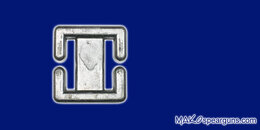What I'm looking for in a buckle is a single handed, single motion release. The Marseille buckle does not provide me with that, Mark's buckle and the wire bail buckle do...
Perhaps I am missing something. I wish Mark's buckle had a product name. Anyway, both require three steps: grabbing a flopping end, pulling right or left, and releasing the grasp. I don’t understand how it is different. It can be argued that a cam buckle only requires two, hook with fingers and pull. However I doubt timed tests would produce repeatable differences between all three longer than ¼ of a second.
For those who have not seen either buckle, The Marseille buckle is basically a typical Men's belt buckle on steroids. Mark's buckle is an elegantly executed 2" wide hook and loop. Unfortunately, there are no decent photos available on the Web. Tension is increased by pulling a tail on the loop end and the belt is released by pulling a tail on the hook end. A knob of sorts is provided for one end so they are easily distinguished by feel.
Here is my assessment of the characteristics of both:
Mark's design adjusts tighter very easily in the water with one hand, the Marseille is a two-handed task and will be lost if it slips from the hand, but a rubber belt makes the need to tighten unlikely.
You can easily tighten either belt much tighter than a Scuba cam buckle.
A downside of Mark's buckle is it is injection molded plastic and can be damaged by dropping a belt where a hip weight happens to land on the hook end on a hard deck. I believe it is glass-filled material and is very tough, but still plastic. Most Marseille bucks are made from 8mm (5/16") stainless steel round stock. Dropping would damage the rubber belt before the buckle.
Mark's buckle attaches to both ends and makes it impossible for individual weights to slide off the belt, unlike the Marseille. This makes adding or subtracting weights easier on a Marseille buckle, which is a big deal for freedivers so they can adjust for their current operating depth, not such a factor in Scuba.
A webbing belt will take more weight than a rubber belt that tends to stretch out too much above about 25 Lbs. However, there is no stretch so it can’t be worn nearly as low on the hip, if that is desirable in your situation.
I have heard a complaint from a dive shop about Mark's buckle that customers have trouble figuring out how to assemble them and there are no instructions at all.
I do not believe that either will accidentally release and both are easily released in an emergency, probably easier than a cam buckle. All three need some minimal trial to get used to.
It is interesting that we still have not found the universally acceptable buckle after all these years. I encourage people to look at both. IMHO, they are a significant improvement over metal or plastic cam Scuba buckles. Perhaps Thal can expand or correct this review.






